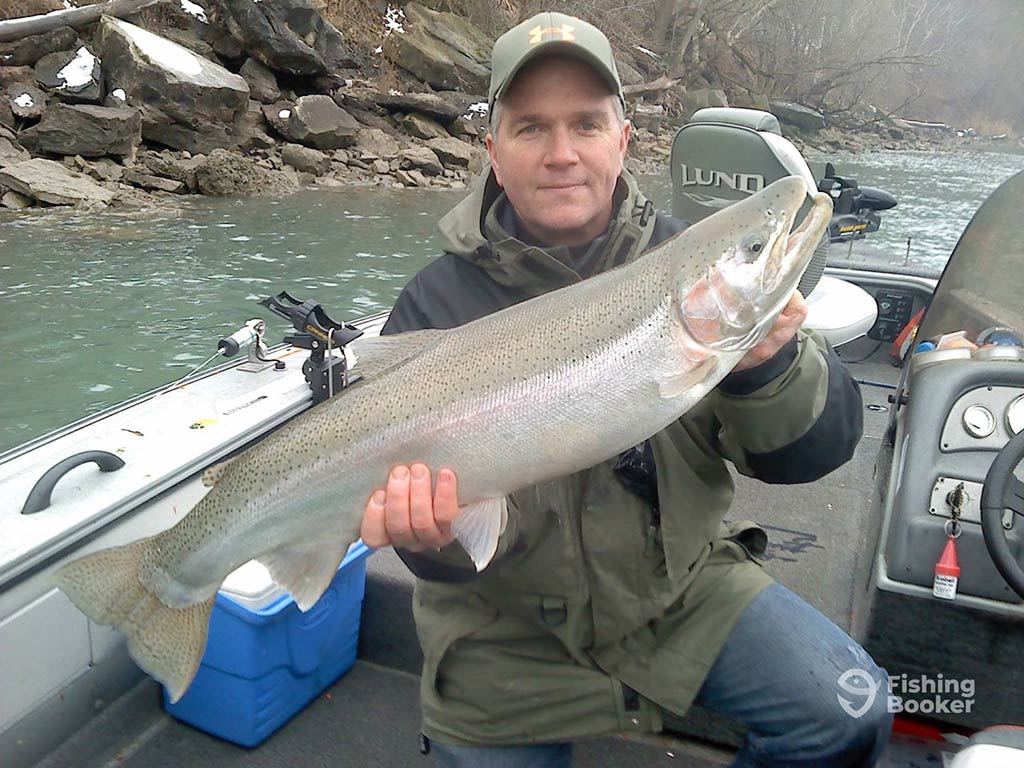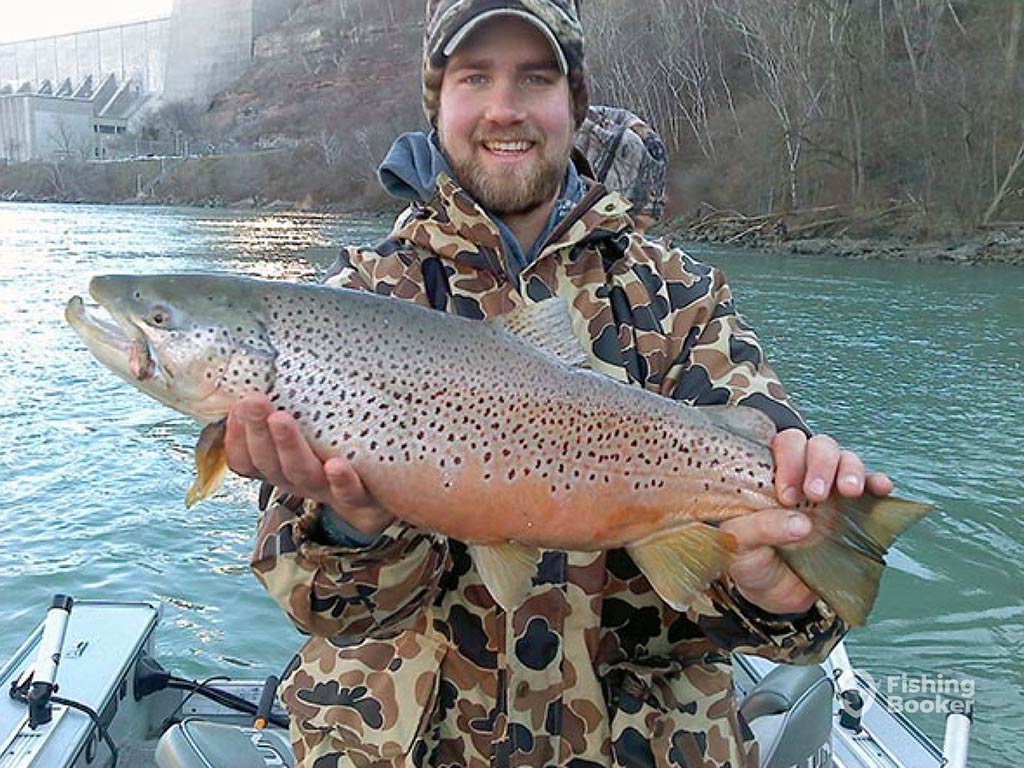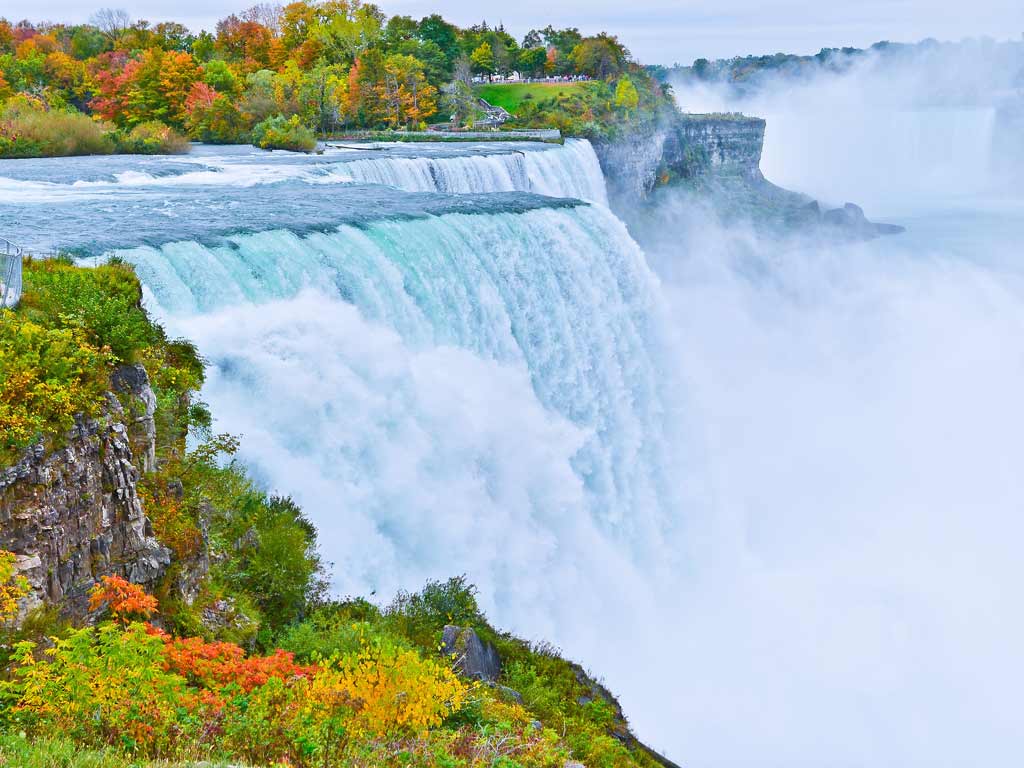If you’re looking for a unique waterway to explore, look no further than the Niagara River. Creating a natural border between the US and Canada, it’s considered a top fishing spot in both countries – and for good reason. When you head out on a Niagara River fishing trip you’ll have the opportunity to hook into both fun-to-catch and delicious fish, year-round.

There are more than a few things that make the river so unique. First of all, it’s divided into two distinct parts by the mighty Niagara Falls. As such, it can feel like you’re fishing completely two different bodies of water. The Upper River is shallower and slower, housing its own set of fish species, compared to the Lower River, which is faster and deeper.
Despite the fact that you’ll have the opportunity to choose when, where, and what to fish for, the Niagara River is fickle. The currents can be testy and water levels fluctuate often. In this guide, we aim to give you the know-how necessary to make your trip both safe and successful.
Best Fish to Catch in the Niagara River
A better question might be what fish aren’t in the Niagara River? This freshwater haven is home to over a hundred different species, 45 of which spawn here. We couldn’t highlight them all, so without further ado here are our top Niagara targets.
Salmon

Few freshwater fish have as celebrated a reputation as Salmon. Delicious, hard-fighting, and available in a limited capacity, these fish tick all the boxes. In the Niagara River, you’ll have the opportunity to go after two of the most sought-after varieties – Chinook and Coho.
You’ll find them in the Lower River, where it empties out into Lake Ontario, starting early September. Chinook come to spawn first and typically hit peak numbers in the second half of the month. They’ll stick around well into October and even stay until early November some years. Coho spawn a little later, hitting their stride in October.
This section of the river is fast and deep, meaning the fish are even more powerful. You’ll be battling 20–30 lb Chinook Salmon so gear up with 20 lb monofilament line. The waters leading up to productive Salmon fishing spots can be quite turbulent, so if you’re a newcomer, enlisting the help of a guide is strongly recommended.
Steelhead

Another notable resident of the Lower River is Steelhead. These fish start making moves in November, just as we say goodbye to Salmon, and stick around until May. Steelhead are a consistent target for winter anglers and you’ll find them in great numbers even as the ice starts to form. Since nearby Lake Erie usually freezes over, the Niagara River is cleaner than usual, attracting even more fish.
The presence of spawning Lake Trout also plays a part. Their eggs are a food source for Steelhead, so gearing up with pink egg sacs for bait is good practice. Once you’ve bundled up, head to the 10-mile stretch of water below the falls. Anglers here often boat 10–15 fish per day. The winter weather keeps the crowds at bay and it’s likely you’ll be reeling in 10 lb Steelhead all by yourself.
Brown and Lake Trout

Anglers love to fish the Niagara River for Brown and Lake Trout for different reasons. Lake Trout are a great target for novice anglers, whereas Browns are some of the hardest Trout to catch. Browns here get big, with some specimens hitting the 30 lb mark. You can either put on your waders, head out on a float trip, or fly fish from the banks to hook ’em.
Lake Trout are caught in the same way, and the summer emerald shiner run is a great time to get their hands on them. In terms of seasonality, you’ll find Browns in the Niagara River at the same time as Steelhead. Lake Trout are a year-round target but bear in mind that fishing for them is prohibited from October to December.
Walleye

You’ll find Walleye in both the Upper and Lower River – especially from May–September. During this time, most of the fish congregate near Fort Niagara, at the mouth of the river where it empties into Lake Ontario. To get your hands on a trophy, try trolling the weed beds in spring. In the height of summer, head out on a drift boat and gear up with worm harnesses.
Remember, Walleye prefer low light so aside from fishing before sunrise and after sunset, it’s a good idea to search areas with cover. Apart from being so plentiful, the other big draw for Walleye anglers in the Niagara River is their size. You’ll find plenty in the 8 lb range and some hit well over the 10 lb mark.
Bass

You’ll find Largemouth and Smallmouth Bass throughout this waterway, but for the hardest fighting specimens, head to the Upper River. Smallmouth Bass are definitely the stars of the show. They prefer the slower waters, which is great news for you. It’s far less busy than the Lower River and a lot of the time, you’ll have the fish to yourself.
To successfully fish for Smallmouth Bass, seek out weed beds, ledges, and deep holes. Gear up with 10–20 lb braided line or pair a light tackle spinning rod with a sinker to access those secluded areas. Drift fishing and casting from the shore are both suitable for hooking your next Bass.
And More!
Like we mentioned in our introduction, there are a lot of fish to target in the Niagara River. In the upper sections of the river, above the Falls, you can add Perch, Northern Pike, and Muskellunge to your target list. You’ll find these same fish below the Falls, as well as Channel Catfish and even Carp on occasion.
Recent Niagara River Catches
Fresh fishing reports from anglers
How to Fish the Niagara River
The Niagara River isn’t always easy to navigate. There’s a large volume of water here and some sections of the river are very fast and unpredictable. There are more ways to fish the river than the ones listed below, however, we believe these to be the safest across the board.
Charter Boat Fishing

Specifically if you’re new to the river, we can’t recommend hiring a Niagara River fishing charter enough. Having a knowledgeable captain with you is an indispensable advantage, especially if you’re tackling stretches of the river that are tricky. They’ll take command of the vessel as well as share their top tips and secret honey holes with you.
If you’re hoping to troll for Trout and Salmon, you’ll find a wide variety of boats with powerful engines to give you speed and help you navigate the waters. Niagara River float trips are a big deal in the spring and are a great way to target Bass, Walleye, and Lake Trout.
Shore Fishing

Fishing the Niagara River from shore can be a very fulfilling experience. There are plenty of places on both the Lower and Upper River where you can cast a line for coveted targets like Walleye, Pike, Bass, and Trout without stepping foot on a boat.
Shore fishing spots on the Upper River are much more accessible, but if you’re heading to the Lower River – bring your hiking boots. Reaching popular areas requires hoofing it down some steep hills. When fishing the river from the shore, cast upstream and give your line enough slack to drift downstream naturally.
Niagara River Fishing Spots
The Niagara River creates the border between Canada and the United States, and there are ample fishing spots in both countries. Below we highlight a few of our favorites to help you get started.

- Whirlpool State Park: This honey hole is a perfect spot to hook Salmon, Steelhead, Browns, and Lakers. Cast from shore or boat down from the northern launch – but beware. They call it “Whirlpool” for a reason, water levels can fluctuate drastically and the current spins back and forth.
- Devil’s Hole State Park: Located a few miles below Niagara Falls, Devil’s Hole is a prime fall Salmon and winter Steelhead fishery. The waters in Devil’s Hole itself are calm, but the boat ride here will see you go up against a strong current. Enlist a guide if you’re new to the area.
- Strawberry Island: Anglers targeting Bass in the Upper River should head to the area surrounding Strawberry Island. This spot is especially great for early season Smallmouth Bass!
- Lewiston: Launching from Lewiston, New York gives you great access to the mouth of the Niagara River. With plenty of boat ramps and shore fishing spots, it’s a great all-around choice for anglers targeting Walleye, Yellow Perch, Trout, and Bass.
- The Niagara Bar: As its name implies, the Bar is a sandbar that holds a wide variety of baitfish. As such, it’s fishable year-round. Depending on the season, you’ll find Chinook and Coho Salmon here, as well as Steelhead and Brown and Lake Trout.
When to Fish the Niagara River

As you’d expect from a river connecting two of the Great Lakes, it’s always possible to go fishing in the Niagara River. While the waters are prone to ice over in the depths of winter, they can thaw pretty quickly, opening up a thriving Steelhead fishery as early as January. Brown and Lake Trout, along with Chinook Salmon aren’t far behind them, lasting into early spring when the Steelheads will start tailing off.
Bass and Walleye take center stage as the season really gets going, before oversized Lake Trout are the stars of the show come summer. Steelhead and Smallmouth Bass are popular in the lower ends of the river, with Muskies showing up in the north. This is a great warmup for the second Salmon season, which takes place in fall. This time, Coho Salmon join their Chinook brethren to keep the fishing action hot through the end of the year.
Niagara Fishing Rules and Regulations

Like any other waterway, the Niagara River is subject to fishing regulations. The first thing you’ll need to make sure of is that you have the right fishing license. If you’re fishing on the American side of the border, make sure to buy a New York fishing license for all anglers over the age of 16. You can find out more about the different license types in this guide.
Fishing on the Canadian side? Get an Ontario fishing license for anglers aged 18–64 before hopping on a fishing charter or casting from the shore. Canadian and American fisheries on the Niagara River are subject to differing possession and bag limits. These can change on an annual basis so make sure you read up on the regulations before heading out.
Good to eat?
The Niagara River’s water quality has improved over the last three decades, however, caution should still be used when consuming fish caught here. There are some fish you shouldn’t eat at all, and others where a maximum of four meals per month is recommended. To ensure safe eating choose smaller fish, trim skin and fat, and cook your catch.
Niagara River Fishing: Powerful and Exciting

Mention Niagara and most minds jump to the Falls, but there’s more than one powerful and exciting waterway to see and explore in this region. If you’re up for a freshwater adventure and year-round fishing for some of the most coveted species on the East Coast, this is where you want to be. A Niagara River fishing trip is worthy of your bucket list – you won’t regret it!
Have you fished the Niagara River before? What are your favorite spots to cast a line? Let us know in the comments – we love to hear from you!


